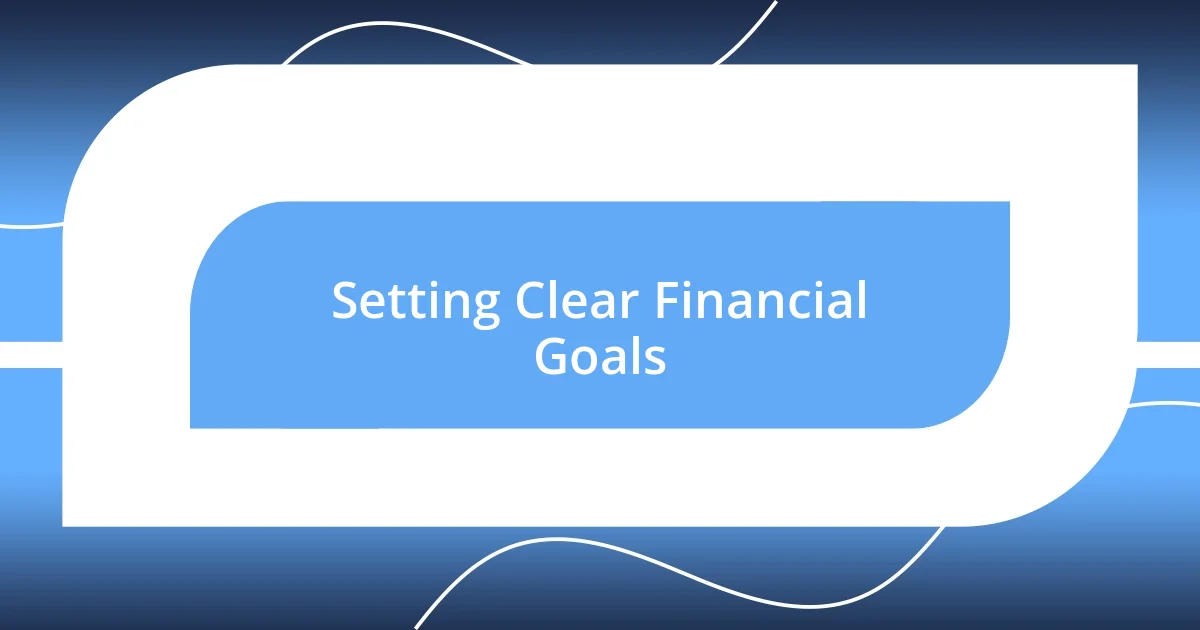Key takeaways:
- Financial independence is about freedom and peace of mind, not just accumulating wealth; achieving it requires thoughtful budgeting and savings.
- Setting clear financial goals, categorized by short-term, medium-term, and long-term, is essential for maintaining focus and accountability on the financial journey.
- Creating a budget, building an emergency fund, investing for growth, and exploring passive income streams are crucial steps that provide security, resilience, and the potential for financial autonomy.

Understanding Financial Independence
Financial independence is more than just a number in your bank account; it’s about having the freedom to make choices without being driven by financial constraints. I’ll never forget the moment I realized I could choose where to work instead of needing to chase the highest paycheck. This realization transformed my perspective on life and financial security.
What does financial independence mean to you? For me, it’s the ability to wake up each day and pursue my passions without the looming pressure of bills and debts. When I started budgeting thoughtfully and prioritizing my savings, I felt a weight lift off my shoulders, propelling me further on my journey.
Understanding financial independence also involves the emotional aspect. It’s not merely about accumulating wealth but about achieving peace of mind. I can vividly recall the nerve-wracking days when unexpected expenses would send me into a panic. Now, having a financial cushion brings me a sense of calm that’s priceless. It’s liberating, and that feeling makes every effort I invested worth it.

Setting Clear Financial Goals
Setting clear financial goals is essential in my journey toward financial independence. Without a structured plan, it’s easy to lose sight of what truly matters. I remember when I first started—my goals were all over the place, and I felt overwhelmed. It wasn’t until I took the time to write down my objectives, rather than just thinking about them, that I found clarity and purpose.
It’s also helpful to categorize these goals into short-term, medium-term, and long-term. This approach provides a roadmap. For instance, I often focused on saving for a vacation as my short-term goal, while investing for retirement became a long-term priority. Setting these distinctions helped me prioritize my resources effectively.
Moreover, I learned that revisiting my goals regularly keeps me accountable and motivated. Life changes, and so do our aspirations. Reflecting on my goals has allowed me to adapt them as needed. I recall a period when I was tempted to spend on a luxury item, but by revisiting my goals, I quickly redirected my focus to saving for a home, which felt far more rewarding.
| Type of Goal | Example |
|---|---|
| Short-term | Saving for a vacation |
| Medium-term | Paying off student loans |
| Long-term | Saving for retirement |

Creating a Budget That Works
Creating a budget that works is a cornerstone in my financial independence journey. I once thought budgeting was just about crunching numbers and restricting spending, but it’s so much more than that. It’s a tool that empowers me to take control of my financial life. I remember the initial struggles—trying to keep track of every dollar felt overwhelming. However, after simplifying my approach, I discovered the beauty of using budgeting apps and spreadsheets that broke everything down into manageable portions.
Here are some practical steps I’ve found particularly effective in creating a budget that truly works for me:
- Determine Your Income: Start by calculating all your income sources, including side hustles.
- Track Expenses: For one month, document everything you spend. It’s an eye-opener!
- Prioritize Needs vs. Wants: Identify essential expenses and differentiate them from discretionary spending.
- Set Savings Goals: Allocate a portion of your budget towards savings; even small amounts add up.
- Review and Adjust: At the end of each month, evaluate your spending. There’s no shame in adjusting as you learn more about your habits.
Through trial and error, I’ve realized that budgeting isn’t one-size-fits-all—it’s a personal journey. The sense of empowerment I felt when I first saw my savings grow gave me confidence that I could actually reach my goals. Budgeting became less about restriction and more about freedom—freedom to spend on what truly matters to me without guilt. Each month, when I review my budget, I feel a sense of accomplishment, reminding me that I am actively working toward my dreams.

Building an Emergency Fund
Building an emergency fund is one of the most empowering steps I took on my financial journey. I remember that feeling of anxiety whenever an unexpected expense came up; it was like a dark cloud hovering over my finances. I decided to tackle that fear by setting aside a specific amount each month into a dedicated savings account. It wasn’t much at first, just $50, but watching that balance grow provided me with a sense of security I hadn’t experienced before.
One pivotal moment for me was when my car broke down unexpectedly. I had just made a small deposit into my emergency fund the week prior, and when the repair bill came, I didn’t panic. Instead, I felt relieved knowing I had that financial cushion to fall back on. How many times have we faced surprise expenses and wished we had been better prepared? Having an emergency fund in place allows you to tackle those hurdles without derailing your financial progress or dipping into debt.
In my experience, a good rule of thumb is to aim for three to six months’ worth of living expenses. I chose to target four months, gradually building towards it. It can feel daunting at first, but as I consistently funded my emergency account, I began to associate my savings with peace of mind rather than just a stale number in a bank account. This was a transformation—knowing that I was taking control of my financial future, one deposit at a time, filled me with a sense of achievement that motivated me to keep going.

Investing for Long-Term Growth
Investing for long-term growth has truly changed my perspective on financial stability. I still remember the first time I put money into the stock market. It felt a bit like jumping into a cold pool—you know it’s good for you, but it takes a moment to acclimate. I started small, investing in index funds that provided me exposure to a broad market without the need to pick individual stocks. This strategy not only diversified my portfolio but also made me feel a sense of security, knowing I was not relying solely on one or two investments.
As I watched my investments grow, I realized the importance of patience. There were moments when market fluctuations made me anxious, but I learned that staying the course was essential. I often asked myself, “Am I prepared to weather the storms of the market?” The answer became clearer with each passing year. I also set goals for myself—like contributing to my retirement account regularly. This consistent investment habit allowed compound interest to work its magic, leading to growth that I once thought was out of reach.
One particular experience taught me the value of long-term thinking. When the market experienced a downturn, I was tempted to pull out my investments. Instead, I decided to keep my cool and hold onto my shares. Looking back, that choice not only helped me recover but also taught me about the resilience required for success in investing. As I continue this journey, I often reflect on how investing isn’t just about creating wealth; it’s about creating a future where financial independence becomes a reality.

Exploring Passive Income Streams
Exploring passive income streams has become a thrilling adventure in my financial journey. I vividly remember the day I read about real estate investment trusts (REITs) for the first time. It felt like unlocking a door to a new world where I could earn money without the constant grind of traditional work. By investing in REITs, I discovered a way to gain exposure to real estate markets without the hassle of property management. And let me tell you, the thought of receiving quarterly dividends made my heart race with excitement!
Another fascinating avenue I explored was creating digital products. I dabbled in writing an e-book on a topic I was passionate about. At first, I questioned whether anyone would actually purchase it—what if it flopped? But once I hit “publish,” I experienced the thrill of seeing my work generate income while I enjoyed my morning coffee. Passive income felt like an extension of my creativity, and it sparked a flame of motivation in me. Have you ever considered that your hobbies could pay off in more ways than one?
Lastly, I delved into peer-to-peer lending platforms. Initially, it seemed daunting. Could I really trust strangers with my money? But after conducting thorough research and starting small, I found the experience both rewarding and educational. Watching my small investments repay with interest opened my eyes to the power of leveraging funds to generate ongoing income. While the risks are certainly there, it’s a reminder that all investments come with a learning curve—and every step taken is an opportunity to gain financial autonomy.

Measuring Progress and Adjusting Goals
Measuring progress on my journey to financial independence has been both an enlightening and humbling experience. I recall the first time I sat down to review my financial goals against my actual savings—it was an eye-opener. I realized that just tracking numbers wasn’t enough; I needed to assess not only the figures but my emotional responses to them. Did I feel proud, anxious, or motivated? Understanding these feelings helped me recalibrate my approach and adjust my expectations when necessary.
As my financial picture evolved, I discovered the importance of flexibility in my goals. There were months when unexpected expenses cropped up, forcing me to shift my focus from aggressive savings to covering basics. I remember grappling with that shift and asking myself whether I was losing momentum. Over time, it became clear that small adjustments were essential for maintaining my peace of mind, and each recalibration moved me closer to my destination. Navigating this journey requires a mindset that embraces change instead of fearing it.
I now break my goals into measurable milestones, which has transformed the way I celebrate achievements. For instance, I started tracking my net worth quarterly, and each increment felt like a mini-victory. I often think about how those small wins can translate into long-term success. Have you ever considered how acknowledging progress, no matter how minor, can propel you forward? These little triumphs remind me that financial independence isn’t just a destination; it’s a journey filled with continuous growth and learning.














